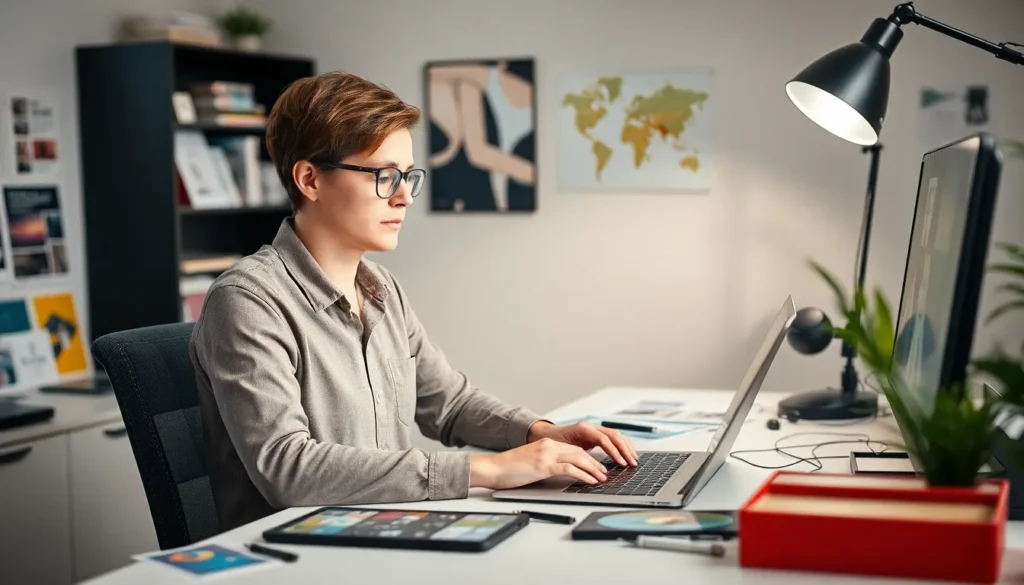Table of Contents
ToggleIn a world where digital creativity meets the wild frontier of cyber threats, protecting your beloved Shotscribus software is like guarding the crown jewels—only with fewer lasers and more pixels. Every designer knows the pain of losing hours of hard work to a rogue virus or an unexpected crash. So how can one safeguard their masterpiece-making tool from the dark forces of the internet?
Overview of Shotscribus Software
Shotscribus software serves as a powerful open-source desktop publishing application. Graphic designers and publishers utilize this tool to create professional-quality layouts for print and digital media. Users appreciate its flexibility, supporting various file formats such as PDF, SVG, and PNG.
The software offers a wide array of features including template management, text formatting, and image handling. Intuitive design elements enable users to efficiently manipulate graphics, arrange elements, and finalize layouts. Collaboration within teams is facilitated by sharing project files across platforms.
An active community surrounds Shotscribus, contributing plugins and extensions that enhance its capabilities. Regular updates ensure software relevance, addressing user feedback and improving functionality. Community forums also provide valuable resources for troubleshooting and sharing best practices.
Security remains a key concern for many users. Every project requires safeguarding against potential data loss or cyber threats. Users often rely on encryption methods and secure backups to protect their work. Maintaining software updates is crucial, as patches often address security vulnerabilities.
With an awareness of these aspects, designers can harness the full potential of Shotscribus while minimizing risks. Overall, Shotscribus not only simplifies the design process but also provides essential tools to ensure creative work remains secure.
Importance of Protecting Software

Protecting software like Shotscribus plays a vital role in maintaining its integrity and usability. Cyber threats jeopardize the creative work of many designers and highlight the necessity for robust protection measures.
Legal Frameworks
Legal frameworks establish guidelines for software protection. They encompass intellectual property laws that safeguard copyrights and patents related to software. Compliance with these regulations ensures that developers maintain exclusive rights over their creations. Users who adhere to licensing agreements help uphold the software’s integrity. Additionally, proper documentation and user agreements can protect both creators and users, creating a secure environment for digital creativity. Laws vary by region, so understanding applicable regulations is crucial for maximum protection.
Ethical Considerations
Ethical considerations significantly impact software protection. Designers must acknowledge the responsibility they hold in protecting their digital work. Respecting original content and avoiding piracy fosters a healthy creative community. Users should value the work of developers by buying licensed products and refraining from unauthorized distribution. Ethical behavior contributes to a culture of trust, making it easier for developers to improve their software and offer support. Upholding ethical standards not only protects individual projects but also nurtures a supportive environment for the entire industry.
Methods to Protect Shotscribus Software
Protecting the Shotscribus software is crucial for maintaining its functionality and the integrity of users’ projects. Several effective methods exist to secure this open-source application against potential threats.
Licensing Agreements
Licensing agreements set clear guidelines for the use of Shotscribus. These contracts establish user rights and limitations, preventing unauthorized distribution. Users benefit from understanding these agreements, as they define the boundaries within which they can operate. With proper licensing, developers can uphold their intellectual property rights, ultimately protecting the software’s integrity. Compliance with these agreements fosters a secure environment for both users and developers, ensuring a sustainable creative community.
Code Obfuscation Techniques
Code obfuscation techniques aim to protect Shotscribus’s source code from reverse engineering. By transforming the code into a format that is difficult to understand, this method makes it harder for attackers to exploit vulnerabilities. Implementing obfuscation involves various approaches, such as renaming variables and altering code structures. This process doesn’t affect the software’s performance but significantly increases security. Employing code obfuscation minimizes risks associated with unauthorized access, safeguarding both the software and its users.
Regular Updates and Patches
Regular updates and patches play a vital role in securing Shotscribus against cyber threats. Developers consistently release updates to address vulnerabilities and improve functionality. Users benefit from maintaining the latest version, as these updates often include critical security enhancements. Installing patches promptly reduces the risk of exploitation by cybercriminals. Frequent updates also contribute to overall software resilience, ensuring that Shotscribus remains a reliable tool for designers and publishers.
Community Involvement
Community involvement plays a crucial role in enhancing the security of Shotscribus software. Engaging users in proactive measures both protects their work and strengthens the software.
User Education
User education focuses on informing designers about potential threats and security best practices. Understanding the importance of regular software updates can significantly reduce vulnerabilities. Workshops and tutorials that teach safe practices help users recognize phishing attempts and malware risks. Online forums provide a platform where experienced users share insights and tips on keeping their work secure. Awareness sessions that explain the significance of encryption further empower individuals to protect their projects effectively.
Reporting Vulnerabilities
Reporting vulnerabilities fosters a collaborative environment for maintaining security within the Shotscribus community. Users who identify bugs or security issues play a critical role in safeguarding the software. Establishing a straightforward reporting process encourages quick responses from developers. Clear guidelines for submitting reports ensure that information reaches the right people efficiently. Active participation in forums allows for discussion on security threats, creating a stronger defense against potential attacks. Swift reporting leads to timely updates and patches that address emerging security concerns.
Protecting Shotscribus software is vital for preserving the creative efforts of designers. By implementing robust security measures and fostering community involvement, users can significantly reduce risks associated with cyber threats. Regular updates and education empower designers to navigate potential vulnerabilities while respecting intellectual property rights.
The collective responsibility of both users and developers ensures a secure environment for creativity to flourish. Engaging in ethical practices and adhering to licensing agreements not only safeguards individual projects but also strengthens the overall integrity of the software. With proactive measures in place, the Shotscribus community can thrive, allowing designers to focus on their craft without fear of losing their valuable work.







